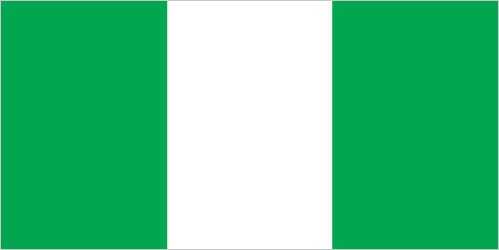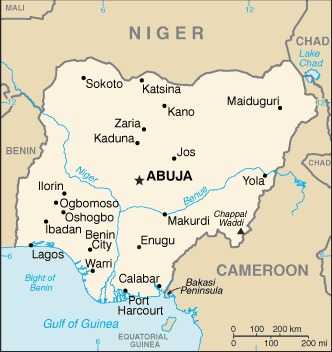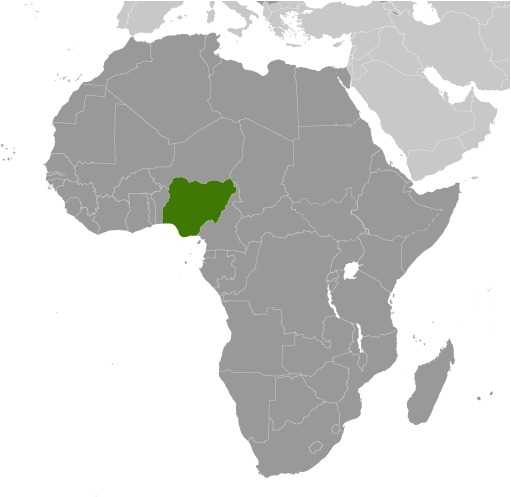Introduction
Background
In ancient and pre-colonial times, the area of present-day Nigeria was occupied by a variety of ethnic groups with different languages and traditions. These included large Islamic kingdoms such as Borno, Kano, and the Sokoto Caliphate dominating the north, the Benin and Oyo Empires that controlled much of modern western Nigeria, and more decentralized political entities and city states in the south and southeast. In 1914, the British amalgamated their separately administered northern and southern territories into a Colony and Protectorate of Nigeria.
Nigeria achieved independence from Britain in 1960 and transitioned to a federal republic with three constituent states in 1963 under President Nnamdi AZIKIWE. This structure served to enflame regional and ethnic tension, contributing to a bloody coup led by predominately southeastern military officers in 1966 and a countercoup later that year masterminded by northern officers. In the aftermath of this tension, the governor of Nigeria’s Eastern Region, centered on the southeast, declared the region independent as the Republic of Biafra. The ensuring civil war (1967-1970), resulted in more than a million deaths, many from starvation. While the war forged a stronger Nigerian state and national identity, it contributed to long-lasting mistrust of the southeast’s predominantly Igbo population. Wartime military leader Yakubu GOWON ruled until a bloodless coup by frustrated junior officers in 1975. This generation of officers, including Olusegun OBASANJO, Ibrahim BABANGIDA, and Muhammadu BUHARI, who would all later serve as president, continue to exert significant influence in Nigeria to the present day.
Military rule predominated until the first durable transition to civilian government and adoption of a new constitution in 1999. The elections of 2007 marked the first civilian-to-civilian transfer of power in the country's history. National and state elections in 2011 and 2015 were generally regarded as credible. The 2015 election was also heralded for the fact that the then-umbrella opposition party, the All Progressives Congress, defeated the long-ruling (since 1999) People's Democratic Party and assumed the presidency, marking the first peaceful transfer of power from one party to another. Presidential and legislative elections in 2019 and 2023 were deemed broadly free and fair despite voting irregularities, intimidation, and violence. The government of Africa's most populous nation continues to face the daunting task of institutionalizing democracy and reforming a petroleum-based economy whose revenues have been squandered through decades of corruption and mismanagement. In addition, Nigeria faces increasing violence from Islamic terrorism, largely in the northeast, large scale criminal banditry, secessionist violence in the southeast, and competition over land and resources nationwide.
Visit the Definitions and Notes page to view a description of each topic.
Geography
Location
Western Africa, bordering the Gulf of Guinea, between Benin and Cameroon
Geographic coordinates
10 00 N, 8 00 E
Map references
Africa
Area - comparative
about six times the size of Georgia; slightly more than twice the size of California
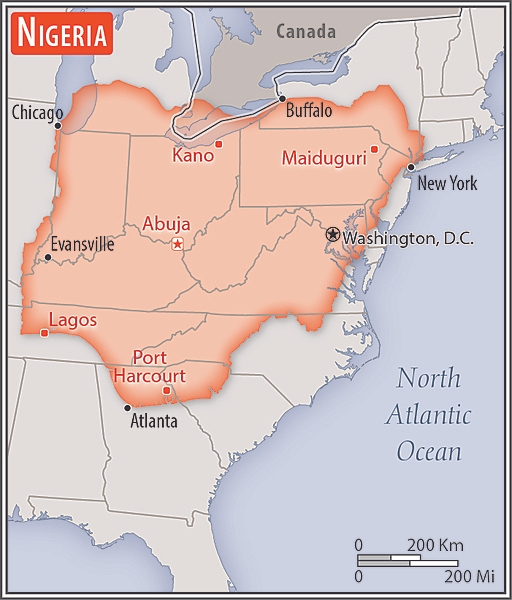
Land boundaries
total: 4,477 km
border countries (4): Benin 809 km; Cameroon 1,975 km; Chad 85 km; Niger 1,608 km
Coastline
853 km
Maritime claims
territorial sea: 12 nm
exclusive economic zone: 200 nm
continental shelf: 200-m depth or to the depth of exploitation
Climate
varies; equatorial in south, tropical in center, arid in north
Terrain
southern lowlands merge into central hills and plateaus; mountains in southeast, plains in north
Elevation
highest point: Chappal Waddi 2,419 m
lowest point: Atlantic Ocean 0 m
mean elevation: 380 m
Natural resources
natural gas, petroleum, tin, iron ore, coal, limestone, niobium, lead, zinc, arable land
Land use
agricultural land: 78% (2018 est.)
arable land: 37.3% (2018 est.)
permanent crops: 7.4% (2018 est.)
permanent pasture: 33.3% (2018 est.)
forest: 9.5% (2018 est.)
other: 12.5% (2018 est.)
Irrigated land
2,930 sq km (2012)
Major lakes (area sq km)
fresh water lake(s): Lake Chad (endorheic lake shared with Niger, Chad, and Cameroon) - 10,360-25,900 sq km
note - area varies by season and year to year
Major rivers (by length in km)
Niger river mouth (shared with Guinea [s], Mali, Benin, and Niger) - 4,200 km
note – [s] after country name indicates river source; [m] after country name indicates river mouth
Major watersheds (area sq km)
Atlantic Ocean drainage: Niger (2,261,741 sq km)
Internal (endorheic basin) drainage: Lake Chad (2,497,738 sq km)
Major aquifers
Lake Chad Basin, Lullemeden-Irhazer Aquifer System
Population distribution
largest population of any African nation; significant population clusters are scattered throughout the country, with the highest density areas being in the south and southwest as shown in this population distribution map
Natural hazards
periodic droughts; flooding
Geography - note
the Niger River enters the country in the northwest and flows southward through tropical rain forests and swamps to its delta in the Gulf of Guinea
People and Society
Population
total: 236,747,130
male: 119,514,449
female: 117,232,681 (2024 est.)
comparison rankings: female 6; male 6; total 6
Nationality
noun: Nigerian(s)
adjective: Nigerian
Ethnic groups
Hausa 30%, Yoruba 15.5%, Igbo (Ibo) 15.2%, Fulani 6%, Tiv 2.4%, Kanuri/Beriberi 2.4%, Ibibio 1.8%, Ijaw/Izon 1.8%, other 24.9% (2018 est.)
note: Nigeria, Africa's most populous country, is composed of more than 250 ethnic groups
Languages
English (official), Hausa, Yoruba, Igbo (Ibo), Fulani, over 500 additional indigenous languages
Religions
Muslim 53.5%, Roman Catholic 10.6%, other Christian 35.3%, other 0.6% (2018 est.)
Demographic profile
Nigeria’s population is projected to grow from more than 186 million people in 2016 to 392 million in 2050, becoming the world’s fourth most populous country. Nigeria’s sustained high population growth rate will continue for the foreseeable future because of population momentum and its high birth rate. Abuja has not successfully implemented family planning programs to reduce and space births because of a lack of political will, government financing, and the availability and affordability of services and products, as well as a cultural preference for large families. Increased educational attainment, especially among women, and improvements in health care are needed to encourage and to better enable parents to opt for smaller families.
Nigeria needs to harness the potential of its burgeoning youth population in order to boost economic development, reduce widespread poverty, and channel large numbers of unemployed youth into productive activities and away from ongoing religious and ethnic violence. While most movement of Nigerians is internal, significant emigration regionally and to the West provides an outlet for Nigerians looking for economic opportunities, seeking asylum, and increasingly pursuing higher education. Immigration largely of West Africans continues to be insufficient to offset emigration and the loss of highly skilled workers. Nigeria also is a major source, transit, and destination country for forced labor and sex trafficking.
Age structure
0-14 years: 40.4% (male 48,856,606/female 46,770,810)
15-64 years: 56.2% (male 66,897,900/female 66,187,584)
65 years and over: 3.4% (2024 est.) (male 3,759,943/female 4,274,287)
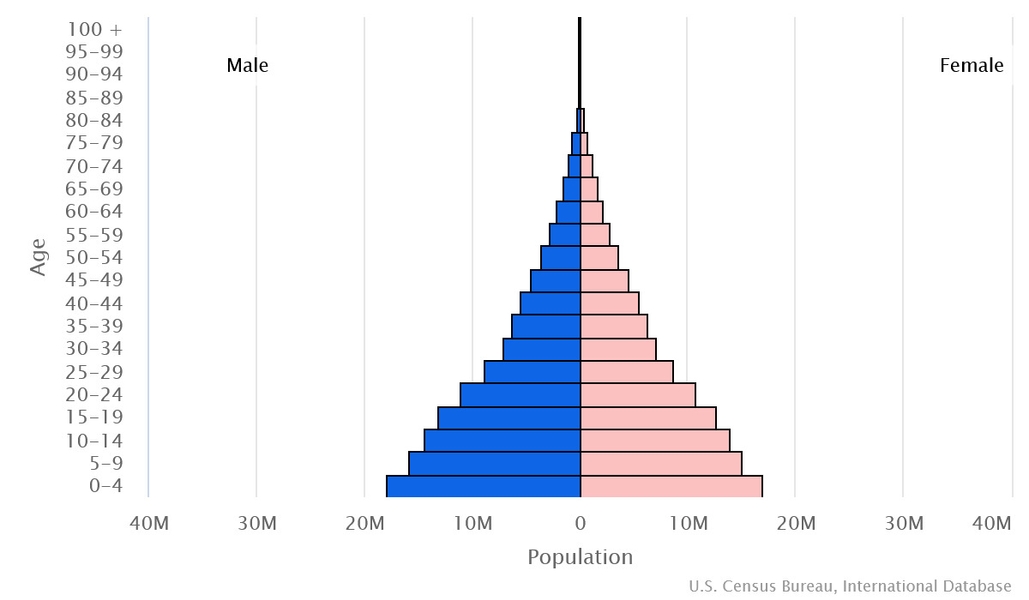
Dependency ratios
total dependency ratio: 86
youth dependency ratio: 80.6
elderly dependency ratio: 5.5
potential support ratio: 18 (2021 est.)
Median age
total: 19.3 years (2024 est.)
male: 19.1 years
female: 19.6 years
comparison ranking: total 211
Population distribution
largest population of any African nation; significant population clusters are scattered throughout the country, with the highest density areas being in the south and southwest as shown in this population distribution map
Urbanization
urban population: 54.3% of total population (2023)
rate of urbanization: 3.92% annual rate of change (2020-25 est.)
Major urban areas - population
15.946 million Lagos, 4.348 million Kano, 3.875 million Ibadan, 3.840 million ABUJA (capital), 3.480 million Port Harcourt, 1.905 million Benin City (2023)
Sex ratio
at birth: 1.06 male(s)/female
0-14 years: 1.04 male(s)/female
15-64 years: 1.01 male(s)/female
65 years and over: 0.88 male(s)/female
total population: 1.02 male(s)/female (2024 est.)
Mother's mean age at first birth
20.4 years (2018 est.)
note: data represents median age at first birth among women 25-49
Infant mortality rate
total: 53.7 deaths/1,000 live births (2024 est.)
male: 58.9 deaths/1,000 live births
female: 48.2 deaths/1,000 live births
comparison ranking: total 15
Life expectancy at birth
total population: 62.2 years (2024 est.)
male: 60.4 years
female: 64.2 years
comparison ranking: total population 216
Gross reproduction rate
2.19 (2024 est.)
Contraceptive prevalence rate
16.6% (2018)
Drinking water source
improved: urban: 95.3% of population
rural: 68.8% of population
total: 82.6% of population
unimproved: urban: 4.7% of population
rural: 31.2% of population
total: 17.4% of population (2020 est.)
Current health expenditure
3.4% of GDP (2020)
Physician density
0.38 physicians/1,000 population (2018)
Sanitation facility access
improved: urban: 81.6% of population
rural: 41.4% of population
total: 62.3% of population
unimproved: urban: 18.4% of population
rural: 58.6% of population
total: 37.7% of population (2020 est.)
Major infectious diseases
degree of risk: very high (2023)
food or waterborne diseases: bacterial and protozoal diarrhea, hepatitis A, and typhoid fever
vectorborne diseases: malaria, dengue fever, and sexually transmitted diseases: hepatitis B (2024)
water contact diseases: schistosomiasis
animal contact diseases: rabies
respiratory diseases: meningococcal meningitis
aerosolized dust or soil contact diseases: Lassa fever
note 1: on 4 May 2022, the Centers for Disease Control and Prevention issued a Travel Health Notice for a Yellow Fever outbreak in Nigeria; a large, ongoing outbreak of yellow fever in Nigeria began in September 2017; the outbreak is now spread throughout the country with the Nigerian Ministry of Health reporting cases of the disease in multiple states (Bauchi, Benue, Delta, Ebonyi, and Enugu); the CDC recommends travelers going to Nigeria should receive vaccination against yellow fever at least 10 days before travel and should take steps to prevent mosquito bites while there; those never vaccinated against yellow fever should avoid travel to Nigeria during the outbreak (see attached map)
note 2: on 31 August 2023, the US Centers for Disease Control and Prevention (CDC) issued a Travel Alert for polio in Africa; Nigeria is currently considered a high risk to travelers for circulating vaccine-derived polioviruses (cVDPV); vaccine-derived poliovirus (VDPV) is a strain of the weakened poliovirus that was initially included in oral polio vaccine (OPV) and that has changed over time and behaves more like the wild or naturally occurring virus; this means it can be spread more easily to people who are unvaccinated against polio and who come in contact with the stool or respiratory secretions, such as from a sneeze, of an “infected” person who received oral polio vaccine; the CDC recommends that before any international travel, anyone unvaccinated, incompletely vaccinated, or with an unknown polio vaccination status should complete the routine polio vaccine series; before travel to any high-risk destination, the CDC recommends that adults who previously completed the full, routine polio vaccine series receive a single, lifetime booster dose of polio vaccine
note 3: on 20 September 2023, the Centers for Disease Control and Prevention updated a Travel Health Alert for a diphtheria outbreak in several states in Nigeria; vaccination against diphtheria is essential to protect against disease; if you are traveling to an affected area, you should be up to date with your diphtheria vaccines; before travel, discuss the need for a booster dose with your healthcare professional; diphtheria is a serious infection caused by strains of Corynebacterium diphtheriae bacteria that make a toxin from which people get very sick; diphtheria bacteria spread from person to person through respiratory droplets like from coughing or sneezing; people can also get sick from touching open sores or ulcers of people sick with diphtheria (see attached map)
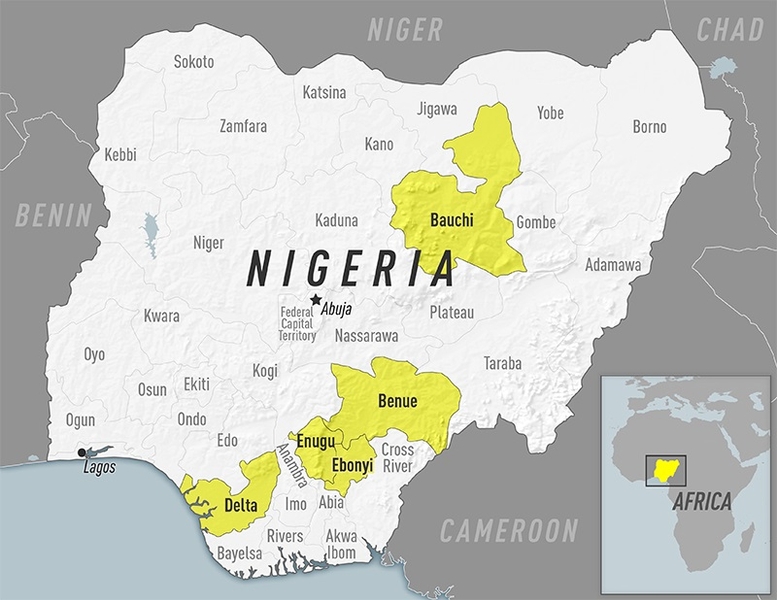
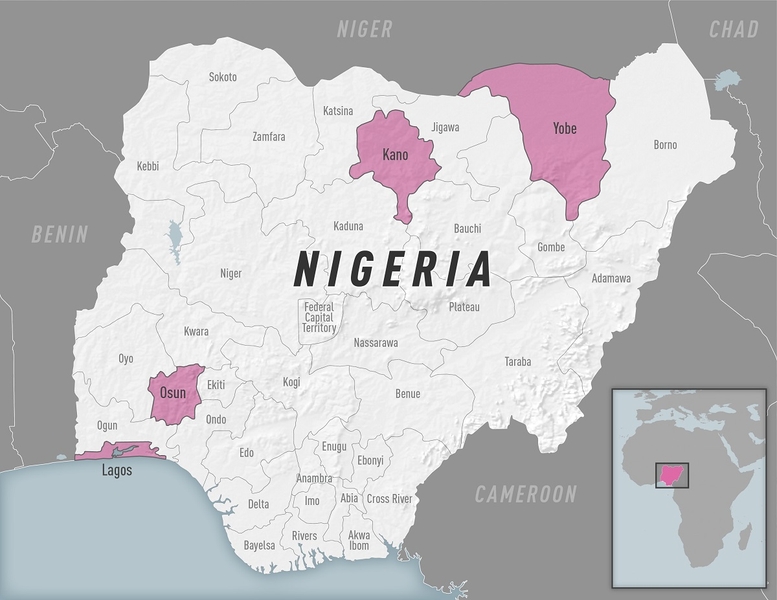
Alcohol consumption per capita
total: 4.49 liters of pure alcohol (2019 est.)
beer: 0.73 liters of pure alcohol (2019 est.)
wine: 0.09 liters of pure alcohol (2019 est.)
spirits: 0.4 liters of pure alcohol (2019 est.)
other alcohols: 3.27 liters of pure alcohol (2019 est.)
comparison ranking: total 88
Tobacco use
total: 3.7% (2020 est.)
male: 6.9% (2020 est.)
female: 0.5% (2020 est.)
comparison ranking: total 163
Currently married women (ages 15-49)
66.2% (2023 est.)
Child marriage
women married by age 15: 12.3%
women married by age 18: 30.3%
men married by age 18: 1.6% (2021 est.)
note: due to prolonged insecurity concerns, some parts of states, including Borno state, were not sampled
Literacy
definition: age 15 and over can read and write
total population: 62%
male: 71.3%
female: 52.7% (2018)
Environment
Environment - current issues
serious overpopulation and rapid urbanization have led to numerous environmental problems; urban air and water pollution; rapid deforestation; soil degradation; loss of arable land; oil pollution - water, air, and soil have suffered serious damage from oil spills
Environment - international agreements
party to: Biodiversity, Climate Change, Climate Change-Kyoto Protocol, Climate Change-Paris Agreement, Comprehensive Nuclear Test Ban, Desertification, Endangered Species, Hazardous Wastes, Law of the Sea, Marine Dumping-London Convention, Marine Dumping-London Protocol, Marine Life Conservation, Nuclear Test Ban, Ozone Layer Protection, Ship Pollution, Wetlands
signed, but not ratified: Tropical Timber 2006
Climate
varies; equatorial in south, tropical in center, arid in north
Land use
agricultural land: 78% (2018 est.)
arable land: 37.3% (2018 est.)
permanent crops: 7.4% (2018 est.)
permanent pasture: 33.3% (2018 est.)
forest: 9.5% (2018 est.)
other: 12.5% (2018 est.)
Urbanization
urban population: 54.3% of total population (2023)
rate of urbanization: 3.92% annual rate of change (2020-25 est.)
Food insecurity
widespread lack of access: due to persistent civil conflict in the northern areas, floods, high food prices, and an economic slowdown - about 25.3 million people are projected to face acute food insecurity during the June to August 2023 lean season; this would be a significant deterioration compared to last year, when 19.45 million people were estimated to be acutely food insecure; acute food insecurity is mostly driven by the deterioration of security conditions and conflicts in northern states, which have led to the displacement of about 3.17 million people as of March 2022 (the latest data available) and are constraining farmers’ access to their lands; widespread flooding in 2022, affecting about 4.5 million people across the country, has further compounded conditions, particularly in areas already facing high levels of insecurity; high food prices and the expected slowdown in economic growth in 2023 are additional drivers of acute food insecurity (2023)
Air pollutants
particulate matter emissions: 55.64 micrograms per cubic meter (2019 est.)
carbon dioxide emissions: 120.37 megatons (2016 est.)
methane emissions: 143.99 megatons (2020 est.)
Waste and recycling
municipal solid waste generated annually: 27,614,830 tons (2009 est.)
Major lakes (area sq km)
fresh water lake(s): Lake Chad (endorheic lake shared with Niger, Chad, and Cameroon) - 10,360-25,900 sq km
note - area varies by season and year to year
Major rivers (by length in km)
Niger river mouth (shared with Guinea [s], Mali, Benin, and Niger) - 4,200 km
note – [s] after country name indicates river source; [m] after country name indicates river mouth
Major watersheds (area sq km)
Atlantic Ocean drainage: Niger (2,261,741 sq km)
Internal (endorheic basin) drainage: Lake Chad (2,497,738 sq km)
Major aquifers
Lake Chad Basin, Lullemeden-Irhazer Aquifer System
Total water withdrawal
municipal: 5 billion cubic meters (2020 est.)
industrial: 1.97 billion cubic meters (2020 est.)
agricultural: 5.51 billion cubic meters (2020 est.)
Total renewable water resources
286.2 billion cubic meters (2020 est.)
Government
Country name
conventional long form: Federal Republic of Nigeria
conventional short form: Nigeria
etymology: named for the Niger River that flows through the west of the country to the Atlantic Ocean; from a native term "Ni Gir" meaning "River Gir"
Government type
federal presidential republic
Capital
name: Abuja
geographic coordinates: 9 05 N, 7 32 E
time difference: UTC+1 (6 hours ahead of Washington, DC, during Standard Time)
etymology: Abuja is a planned capital city, it replaced Lagos in 1991; situated in the center of the country, Abuja takes its name from a nearby town, now renamed Suleja
Administrative divisions
36 states and 1 territory*; Abia, Adamawa, Akwa Ibom, Anambra, Bauchi, Bayelsa, Benue, Borno, Cross River, Delta, Ebonyi, Edo, Ekiti, Enugu, Federal Capital Territory*, Gombe, Imo, Jigawa, Kaduna, Kano, Katsina, Kebbi, Kogi, Kwara, Lagos, Nasarawa, Niger, Ogun, Ondo, Osun, Oyo, Plateau, Rivers, Sokoto, Taraba, Yobe, Zamfara
Independence
1 October 1960 (from the UK)
National holiday
Independence Day (National Day), 1 October (1960)
Constitution
history: several previous; latest adopted 5 May 1999, effective 29 May 1999
amendments: proposed by the National Assembly; passage requires at least two-thirds majority vote of both houses and approval by the Houses of Assembly of at least two thirds of the states; amendments to constitutional articles on the creation of a new state, fundamental constitutional rights, or constitution-amending procedures requires at least four-fifths majority vote by both houses of the National Assembly and approval by the Houses of Assembly in at least two thirds of the states; passage of amendments limited to the creation of a new state require at least two-thirds majority vote by the proposing National Assembly house and approval by the Houses of Assembly in two thirds of the states; amended several times, last in 2018
Legal system
mixed legal system of English common law, Islamic law (in 12 northern states), and traditional law
International law organization participation
accepts compulsory ICJ jurisdiction with reservations; accepts ICCt jurisdiction
Citizenship
citizenship by birth: no
citizenship by descent only: at least one parent must be a citizen of Nigeria
dual citizenship recognized: yes
residency requirement for naturalization: 15 years
Suffrage
18 years of age; universal
Executive branch
chief of state: President Bola Ahmed Adekunle TINUBU (since 29 May 2023)
head of government: President Bola Ahmed Adekunle TINUBU (since 29 May 2023)
cabinet: Federal Executive Council appointed by the president but constrained constitutionally to include at least one member from each of the 36 states
elections/appointments: president directly elected by qualified majority popular vote and at least 25% of the votes cast in 24 of Nigeria's 36 states; president elected for a 4-year term (eligible for a second term); election last held on 25 February 2023 (next to be held on 27 February 2027) note - the president is chief of state, head of government, and commander-in-chief of the armed forces
election results:
2023: Bola Ahmed Adekunle TINUBU elected president; percent of vote - Bola Ahmed Adekunle TINUBU (APC) 36.6%, Atiku ABUBAKAR (PDP) 29.1%, Peter OBI (LP) 25.4%, Rabiu KWANKWASO (NNPP) 6.4%, other 2.5%
2019: Muhammadu BUHARI elected president; percent of vote - Muhammadu BUHARI (APC) 53%, Atiku ABUBAKAR (PDP) 39%, other 8%
Legislative branch
description: bicameral National Assembly consists of:
Senate (109 seats - 3 each for the 36 states and 1 for Abuja-Federal Capital Territory; members directly elected in single-seat constituencies by simple majority vote to serve 4-year terms)
House of Representatives (360 seats statutory, 258 current; members directly elected in single-seat constituencies by simple majority vote to serve 4-year terms)
elections: Senate - last held on 25 February 2023 (next to be held in February 2027)
House of Representatives - last held on 25 February 2023 (next to be held in February 2027)
election results: Senate - percent of vote by party - NA; seats by party - APC 59, PDP 36, LP 8, NNPP 2, SDP 2, YPP 1, APGA 1; composition - men 105, women 4, percentage women 3.7%
House of Representatives - percent of vote by party - NA; seats by party - APC 178, PDP 114, LP 35, NNPP 19, APGA 5, other 7, vacant 2; composition - men 344, women 14, percentage women 3.8%; note - total National Assembly percentage women 3.9%
Judicial branch
highest court(s): Supreme Court (consists of the chief justice and 15 justices)
judge selection and term of office: judges appointed by the president upon the recommendation of the National Judicial Council, a 23-member independent body of federal and state judicial officials; judge appointments confirmed by the Senate; judges serve until age 70
subordinate courts: Court of Appeal; Federal High Court; High Court of the Federal Capital Territory; Sharia Court of Appeal of the Federal Capital Territory; Customary Court of Appeal of the Federal Capital Territory; state court system similar in structure to federal system
Political parties and leaders
Accord Party or ACC [Christopher IMUMOLEN]
Africa Democratic Congress or ADC [Dumebi KACHIKWU]
All Progressives Congress or APC [Bola Ahmed TINUBU]
All Progressives Grand Alliance or APGA [Peter UMEADI]
Labor Party or LP [Peter OBI]
New Nigeria People’s Party or NNPP [Rabiu KWANKWASO]
Peoples Democratic Party or PDP [Atiku ABUBAKAR]
Young Progressive Party or YPP [Prince Malik ADO-IBRAHIM]
International organization participation
ACP, AfDB, ATMIS, AU, C, CD, D-8, ECOWAS, EITI (compliant country), FAO, G-15, G-24, G-77, IAEA, IBRD, ICAO, ICC (national committees), ICCt, ICRM, IDA, IDB, IFAD, IFC, IFRCS, IHO, ILO, IMF, IMO, IMSO, Interpol, IOC, IOM, IPU, ISO, ITSO, ITU, ITUC (NGOs), LCBC, MIGA, MINURSO, MNJTF, MONUSCO, NAM, OAS (observer), OIC, OPCW, OPEC, PCA, UN, UNAMID, UNCTAD, UNESCO, UNHCR, UNIDO, UNIFIL, UNISFA, UNITAR, UNMIL, UNMISS, UNOCI, UNOOSA, UNWTO, UPU, WCO, WFTU (NGOs), WHO, WIPO, WMO, WTO
Diplomatic representation in the US
chief of mission: Ambassador (vacant); Chargé d'Affaires Rabiu LAWAL, (since 10 June 2024)
chancery: 3519 International Court NW, Washington, DC 20008
telephone: [1] (202) 800-7201 (ext. 100)
FAX: [1] (202) 362-6541
email address and website:
info@nigeriaembassyusa.org
https://www.nigeriaembassyusa.org/
consulate(s) general: Atlanta, New York
Diplomatic representation from the US
chief of mission: Ambassador (vacant); Chargé d'Affaires David GREENE (since 31 March 2023)
embassy: Plot 1075 Diplomatic Drive, Central District Area, Abuja
mailing address: 8320 Abuja Place, Washington DC 20521-8320
telephone: [234] (9) 461-4000
FAX: [234] (9) 461-4036
email address and website:
AbujaACS@state.gov
https://ng.usembassy.gov/
consulate(s) general: Lagos
Flag description
three equal vertical bands of green (hoist side), white, and green; the color green represents the forests and abundant natural wealth of the country, white stands for peace and unity
National symbol(s)
eagle; national colors: green, white
National anthem
name: "Arise Oh Compatriots, Nigeria's Call Obey"
lyrics/music: John A. ILECHUKWU, Eme Etim AKPAN, B.A. OGUNNAIKE, Sotu OMOIGUI and P.O. ADERIBIGBE/Benedict Elide ODIASE
note: adopted 1978; lyrics are a mixture of the five top entries in a national contest
National heritage
total World Heritage Sites: 2 (both cultural)
selected World Heritage Site locales: Sukur Cultural Landscape; Osun-Osogbo Sacred Grove
Economy
Economic overview
largest African market economy; enormous but mostly lower middle income labor force; major oil exporter; key telecommunications and finance industries; susceptible to energy prices; regional leader in critical infrastructure; primarily agrarian employment
Real GDP (purchasing power parity)
$1.275 trillion (2023 est.)
$1.239 trillion (2022 est.)
$1.2 trillion (2021 est.)
note: data in 2021 dollars
comparison ranking: 26
Real GDP growth rate
2.86% (2023 est.)
3.25% (2022 est.)
3.65% (2021 est.)
note: annual GDP % growth based on constant local currency
comparison ranking: 113
Real GDP per capita
$5,700 (2023 est.)
$5,700 (2022 est.)
$5,600 (2021 est.)
note: data in 2021 dollars
comparison ranking: 173
GDP (official exchange rate)
$362.815 billion (2023 est.)
note: data in current dollars at official exchange rate
Inflation rate (consumer prices)
24.66% (2023 est.)
18.85% (2022 est.)
16.95% (2021 est.)
note: annual % change based on consumer prices
comparison ranking: 201
Credit ratings
Fitch rating: B (2020)
Moody's rating: B2 (2017)
Standard & Poors rating: B- (2020)
note: The year refers to the year in which the current credit rating was first obtained.
GDP - composition, by sector of origin
agriculture: 21.1% (2016 est.)
industry: 22.5% (2016 est.)
services: 56.4% (2017 est.)
comparison rankings: services 149; industry 127; agriculture 43
GDP - composition, by end use
household consumption: 80% (2017 est.)
government consumption: 5.8% (2017 est.)
investment in fixed capital: 14.8% (2017 est.)
investment in inventories: 0.7% (2017 est.)
exports of goods and services: 11.9% (2017 est.)
imports of goods and services: -13.2% (2017 est.)
Agricultural products
yams, cassava, maize, oil palm fruit, rice, taro, bananas, vegetables, sorghum, groundnuts (2022)
note: top ten agricultural products based on tonnage
Industries
crude oil, coal, tin, columbite; rubber products, wood; hides and skins, textiles, cement and other construction materials, food products, footwear, chemicals, fertilizer, printing, ceramics, steel
Industrial production growth rate
0.72% (2023 est.)
note: annual % change in industrial value added based on constant local currency
comparison ranking: 146
Labor force
75.721 million (2023 est.)
note: number of people ages 15 or older who are employed or seeking work
comparison ranking: 7
Unemployment rate
3.07% (2023 est.)
3.83% (2022 est.)
5.39% (2021 est.)
note: % of labor force seeking employment
comparison ranking: 51
Youth unemployment rate (ages 15-24)
total: 19.6% (2021 est.)
male: 19.8%
female: 19.4%
comparison ranking: total 84
Population below poverty line
40.1% (2018 est.)
note: % of population with income below national poverty line
Gini Index coefficient - distribution of family income
35.1 (2018 est.)
note: index (0-100) of income distribution; higher values represent greater inequality
comparison ranking: 92
Average household expenditures
on food: 59% of household expenditures (2021 est.)
on alcohol and tobacco: 1% of household expenditures (2021 est.)
Household income or consumption by percentage share
lowest 10%: 2.9% (2018 est.)
highest 10%: 26.7% (2018 est.)
note: % share of income accruing to lowest and highest 10% of population
Remittances
5.65% of GDP (2023 est.)
4.26% of GDP (2022 est.)
4.42% of GDP (2021 est.)
note: personal transfers and compensation between resident and non-resident individuals/households/entities
Budget
revenues: $37.298 billion (2019 est.)
expenditures: $59.868 billion (2019 est.)
Current account balance
-$805.777 million (2023 est.)
$1.019 billion (2022 est.)
-$3.254 billion (2021 est.)
note: balance of payments - net trade and primary/secondary income in current dollars
comparison ranking: 132
Exports
$60.261 billion (2023 est.)
$69.091 billion (2022 est.)
$50.856 billion (2021 est.)
note: balance of payments - exports of goods and services in current dollars
comparison ranking: 60
Exports - partners
Spain 13%, India 12%, France 7%, US 7%, Netherlands 6% (2022)
note: top five export partners based on percentage share of exports
Exports - commodities
crude petroleum, natural gas, fertilizers, refined petroleum, gold (2022)
note: top five export commodities based on value in dollars
Imports
$72.251 billion (2023 est.)
$77.049 billion (2022 est.)
$67.478 billion (2021 est.)
note: balance of payments - imports of goods and services in current dollars
comparison ranking: 55
Imports - partners
China 32%, Belgium 11%, Netherlands 10%, India 8%, US 5% (2022)
note: top five import partners based on percentage share of imports
Imports - commodities
refined petroleum, wheat, garments, plastics, cars (2022)
note: top five import commodities based on value in dollars
Reserves of foreign exchange and gold
$35.564 billion (2022 est.)
$40.476 billion (2021 est.)
$36.73 billion (2020 est.)
note: holdings of gold (year-end prices)/foreign exchange/special drawing rights in current dollars
comparison ranking: 49
Exchange rates
nairas (NGN) per US dollar -
Exchange rates:
425.979 (2022 est.)
401.152 (2021 est.)
358.811 (2020 est.)
306.921 (2019 est.)
306.084 (2018 est.)
Energy
Electricity access
electrification - total population: 60.5% (2022 est.)
electrification - urban areas: 89%
electrification - rural areas: 27%
Electricity
installed generating capacity: 11.697 million kW (2022 est.)
consumption: 31.57 billion kWh (2022 est.)
transmission/distribution losses: 5.41 billion kWh (2022 est.)
comparison rankings: transmission/distribution losses 167; consumption 65; installed generating capacity 61
Electricity generation sources
fossil fuels: 78.3% of total installed capacity (2022 est.)
solar: 0.1% of total installed capacity (2022 est.)
hydroelectricity: 21.5% of total installed capacity (2022 est.)
biomass and waste: 0.1% of total installed capacity (2022 est.)
Coal
production: 3.043 million metric tons (2022 est.)
consumption: 3.044 million metric tons (2022 est.)
exports: (2022 est.) less than 1 metric ton
imports: 1,000 metric tons (2022 est.)
proven reserves: 2.144 billion metric tons (2022 est.)
Petroleum
total petroleum production: 1.514 million bbl/day (2023 est.)
refined petroleum consumption: 515,000 bbl/day (2022 est.)
crude oil estimated reserves: 36.89 billion barrels (2021 est.)
Natural gas
production: 39.951 billion cubic meters (2022 est.)
consumption: 20.719 billion cubic meters (2022 est.)
exports: 19.722 billion cubic meters (2022 est.)
proven reserves: 5.761 trillion cubic meters (2021 est.)
Carbon dioxide emissions
118.699 million metric tonnes of CO2 (2022 est.)
from coal and metallurgical coke: 6.8 million metric tonnes of CO2 (2022 est.)
from petroleum and other liquids: 71.255 million metric tonnes of CO2 (2022 est.)
from consumed natural gas: 40.645 million metric tonnes of CO2 (2022 est.)
comparison ranking: total emissions 37
Communications
Telephones - fixed lines
total subscriptions: 97,000 (2022 est.)
subscriptions per 100 inhabitants: (2022 est.) less than 1
comparison ranking: total subscriptions 134
Telephones - mobile cellular
total subscriptions: 222.225 million (2022 est.)
subscriptions per 100 inhabitants: 102 (2022 est.)
comparison ranking: total subscriptions 6
Telecommunication systems
general assessment: one of the larger telecom markets in Africa subject to sporadic access to electricity and vandalism of infrastructure; most Internet connections are via mobile networks; market competition with affordable access; LTE technologies available but GSM is dominant; mobile penetration high due to use of multiple SIM cards and phones; government committed to expanding broadband penetration; operators to deploy fiber optic cable in six geopolitical zones and Lagos; operators invested in base stations to deplete network congestion; submarine cable break in 2020 slowed speeds and interrupted connectivity; Nigeria concluded its first 5G spectrum auction in 2021 and granted licenses to two firms; construction of 5G infrastructure has not yet been completed (2022)
domestic: fixed-line subscribership remains less than 1 per 100 persons; mobile-cellular subscribership is 91 per 100 persons (2021)
international: country code - 234; landing point for the SAT-3/WASC, NCSCS, MainOne, Glo-1 & 2, ACE, and Equiano fiber-optic submarine cable that provides connectivity to Europe and South and West Africa; satellite earth stations - 3 Intelsat (2 Atlantic Ocean and 1 Indian Ocean) (2019)
Broadcast media
nearly 70 federal government-controlled national and regional TV stations; all 36 states operate TV stations; several private TV stations operational; cable and satellite TV subscription services are available; network of federal government-controlled national, regional, and state radio stations; roughly 40 state government-owned radio stations typically carry their own programs except for news broadcasts; about 20 private radio stations; transmissions of international broadcasters are available; digital broadcasting migration process completed in three states in 2018 (2019)
Internet users
total: 115.5 million (2021 est.)
percent of population: 55% (2021 est.)
comparison ranking: total 7
Broadband - fixed subscriptions
total: 65,313 (2020 est.)
subscriptions per 100 inhabitants: 0.03 (2020 est.)
comparison ranking: total 137
Transportation
National air transport system
number of registered air carriers: 13 (2020)
inventory of registered aircraft operated by air carriers: 104
annual passenger traffic on registered air carriers: 8,169,192 (2018)
annual freight traffic on registered air carriers: 19.42 million (2018) mt-km
Heliports
15 (2024)
Pipelines
124 km condensate, 4,045 km gas, 164 km liquid petroleum gas, 4,441 km oil, 3,940 km refined products (2013)
Railways
total: 3,798 km (2014)
standard gauge: 293 km (2014) 1.435-m gauge
narrow gauge: 3,505 km (2014) 1.067-m gauge
note: as of the end of 2018, there were only six operational locomotives in Nigeria primarily used for passenger service; the majority of the rail lines are in a severe state of disrepair and need to be replaced
comparison ranking: total 52
Waterways
8,600 km (2011) (Niger and Benue Rivers and smaller rivers and creeks)
comparison ranking: 17
Merchant marine
total: 928 (2023)
by type: general cargo 23, oil tanker 128, other 777
comparison ranking: total 25
Ports
total ports: 28 (2024)
large: 2
medium: 1
small: 1
very small: 24
ports with oil terminals: 23
key ports: Antan Oil Terminal, Bonny, Lagos, Pennington Oil Terminal
Military and Security
Military and security forces
Armed Forces of Nigeria (AFN): Army, Navy (includes Coast Guard), Air Force
Ministry of Interior: Nigeria Security and Civil Defense Corps (NSCDC); Ministry of Police Affairs: Nigeria Police Force (NPF) (2024)
note 1: the NSCDC is a paramilitary agency commissioned to assist the military in the management of threats to internal security, including attacks and natural disasters
note 2: the Office of the National Security Advisor is responsible for coordinating all security and enforcement agencies, including the Department of State Security (DSS), the NSCDC, the Ministry of Justice, and the NPF; border security responsibilities are shared among the NPF, the DSS, the NSCDC, Nigeria Customs Service, Immigration Service, and the AFN
note 3: some states have created local security forces akin to neighborhood watches in response to increased violence, insecurity, and criminality that have exceeded the response capacity of federal government security forces but as of January 2024, official security forces remained the constitutional perogative of the federal government
Military expenditures
0.7% of GDP (2023 est.)
0.6% of GDP (2022 est.)
0.7% of GDP (2021 est.)
0.6% of GDP (2020 est.)
0.5% of GDP (2019 est.)
comparison ranking: 148
Military and security service personnel strengths
information varies; approximately 135,000 active-duty armed forces personnel (100,000 Army; 20,000 Navy/Coast Guard; 15,000 Air Force); approximately 80,000 Security and Civil Defense Corps; approximately 370,000 police (2023)
Military equipment inventories and acquisitions
the military's inventory consists of a wide variety of imported weapons systems of Chinese, European, Middle Eastern, Russian (including Soviet-era), and US origin; the military is undergoing a considerable modernization program, and in recent years has received equipment from nearly 20 countries with China and Russia as the leading suppliers; Nigeria is also developing a defense-industry capacity, including small arms, armored personnel vehicles, and small-scale naval production (2023)
Military service age and obligation
18-26 years of age for voluntary military service for men and women; no conscription (2023)
Military deployments
190 Sudan/South Sudan (UNISFA) (2024)
note: Nigeria has committed an Army combat brigade (approximately 3,000 troops) to the Multinational Joint Task Force (MNJTF), a regional counter-terrorism force comprised of troops from Benin, Cameroon, Chad, and Niger; MNJTF conducts operations against Boko Haram and other terrorist groups operating in the general area of the Lake Chad Basin and along Nigeria's northeast border; national MNJTF troop contingents are deployed within their own country territories, although cross‐border operations are conducted periodically
Military - note
the Nigerian military is sub-Saharan Africa’s largest and regarded as one of its most capable forces; the military's primary concerns are internal and maritime security, and it faces a number of challenges; the Army is deployed in all 36 of the country's states; in the northeast, it is conducting counterinsurgency/counterterrorist operations against the Boko Haram (BH) and Islamic State of Iraq and ash-Sham in West Africa (ISIS-WA) terrorist groups, where it has deployed as many as 70,000 troops at times and jihadist-related violence has killed an estimated 35-40,000 people, mostly civilians, since 2009; in the northwest, it faces growing threats from criminal gangs--locally referred to as bandits--and violence associated with long-standing farmer-herder conflicts, as well as BH and ISIS-WA terrorists; bandits in the northwestern Nigeria are estimated to number in the low 10,000s and violence there has killed more than 10,000 people since the mid-2010s; the military also continues to protect the oil industry in the Niger Delta region against militants and criminal activity; since 2021, additional troops and security forces have been deployed to eastern Nigeria to quell renewed agitation for a state of Biafra (Biafra seceded from Nigeria in the late 1960s, sparking a civil war that caused more than 1 million deaths)
the Navy is focused on maritime security in the Gulf of Guinea; since 2016, it has developed a maritime strategy, boosted naval training and its naval presence in the Gulf, increased participation in regional maritime security efforts, and acquired a number of new naval platforms, including offshore and coastal patrol craft, fast attack boats, and air assets
the Nigerian military traces its origins to the Nigeria Regiment of the West African Frontier Force (WAFF), a multi-regiment force formed by the British colonial office in 1900 to garrison the West African colonies of Nigeria (Lagos and the protectorates of Northern and Southern Nigeria), Gold Coast, Sierra Leone, and Gambia; the WAFF served with distinction in both East and West Africa during World War I; in 1928, it received royal recognition and was re-named the Royal West African Frontier Force (RWAFF); the RWAFF went on to serve in World War II as part of the British 81st and 82nd (West African) divisions in the East Africa and Burma campaigns; in 1956, the Nigeria Regiment of the RWAFF was renamed the Nigerian Military Forces (NMF) and in 1958, the colonial government of Nigeria took over control of the NMF from the British War Office; the Nigerian Armed Forces were established following independence in 1960 (2023)
Space
Space agency/agencies
National Space Research and Development Agency (NARSDA; established 1999); NARSDA originated from the National Centre for Remote Sensing and National Committee on Space Applications (both established in 1987), and the Directorate of Science (established 1993); Defense Space Administration (DSA; established 2014) (2024)
Space program overview
has a formal national space program, which is one of the largest in Africa; focused on acquiring satellites for agricultural, environmental, meteorology, mining and disaster monitoring, socio-economic development, and security purposes; designs, builds (mostly with foreign assistance), and operates satellites; processes overhead imagery data for analysis and sharing; developing additional capabilities in satellite and satellite payload production, including remote sensing (RS) technologies; has a sounding rocket program for researching rockets and rocket propulsion systems with goal of launching domestically produced satellites into space from a Nigerian spaceport by 2030; has relations and/or cooperation agreements with a variety of foreign space agencies and industries, including those of Algeria, Bangladesh, Belarus, China, Ghana, India, Japan, Kenya, Mongolia, South Africa, Thailand, Turkey, the UK, the US, and Vietnam; has a government-owned satellite company and a small commercial aerospace sector (2024)
note: further details about the key activities, programs, and milestones of the country’s space program, as well as government spending estimates on the space sector, appear in the Space Programs reference guide
Terrorism
Terrorist group(s)
Terrorist group(s): Boko Haram; Islamic State of Iraq and ash-Sham – West Africa; Jama’atu Ansarul Muslimina Fi Biladis-Sudan (Ansaru)
note: details about the history, aims, leadership, organization, areas of operation, tactics, targets, weapons, size, and sources of support of the group(s) appear(s) in the Terrorism reference guide
Transnational Issues
Refugees and internally displaced persons
refugees (country of origin): 89,045 (Cameroon) (2023)
IDPs: 3.09 million (northeast Nigeria; Boko Haram attacks and counterinsurgency efforts in northern Nigeria; communal violence between Christians and Muslims in the middle belt region, political violence; flooding; forced evictions; cattle rustling; competition for resources) (2024)
Illicit drugs
Nigeria is a major hub for transnational drug trafficking networks entrenched throughout the world and supplying cocaine to Asia and Europe, heroin to Europe and North America, and methamphetamine to South Africa, Southeast Asia, Australia, and New Zealand; also exporting massive quantities of opioids such as tramadol and captagon along with crack cocaine; a major source of precursor or essential chemicals used in the production of illicit narcotics
